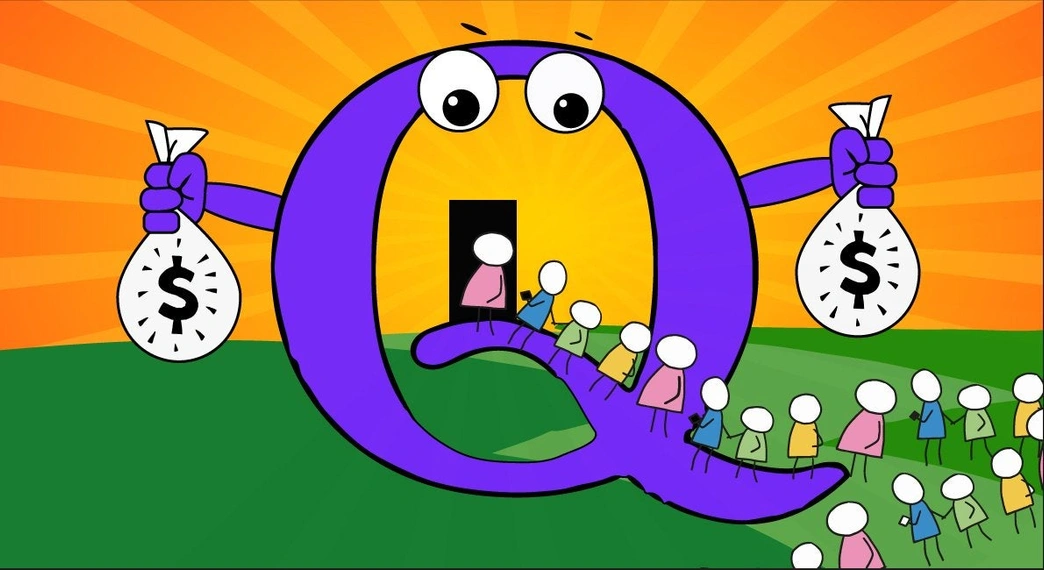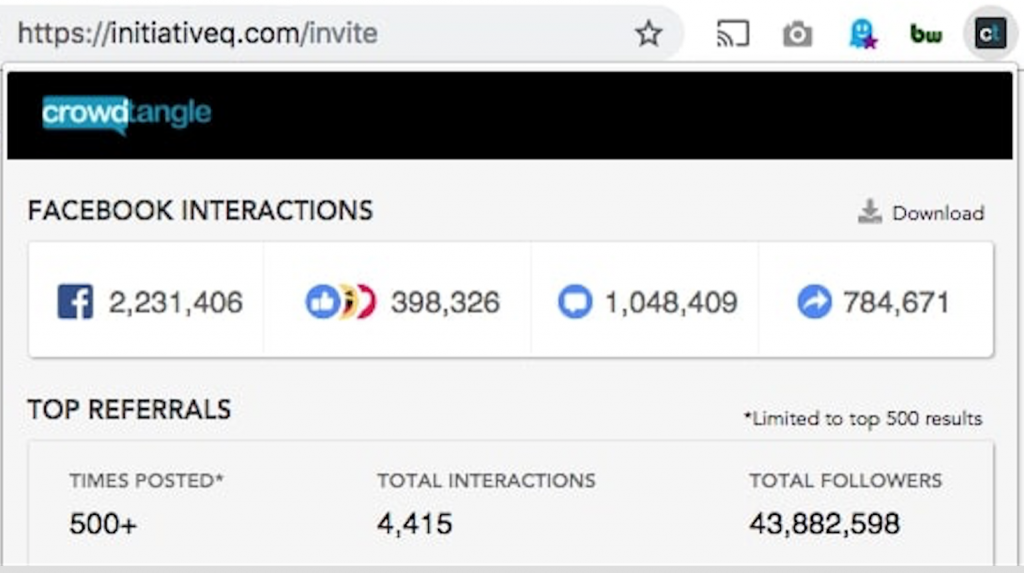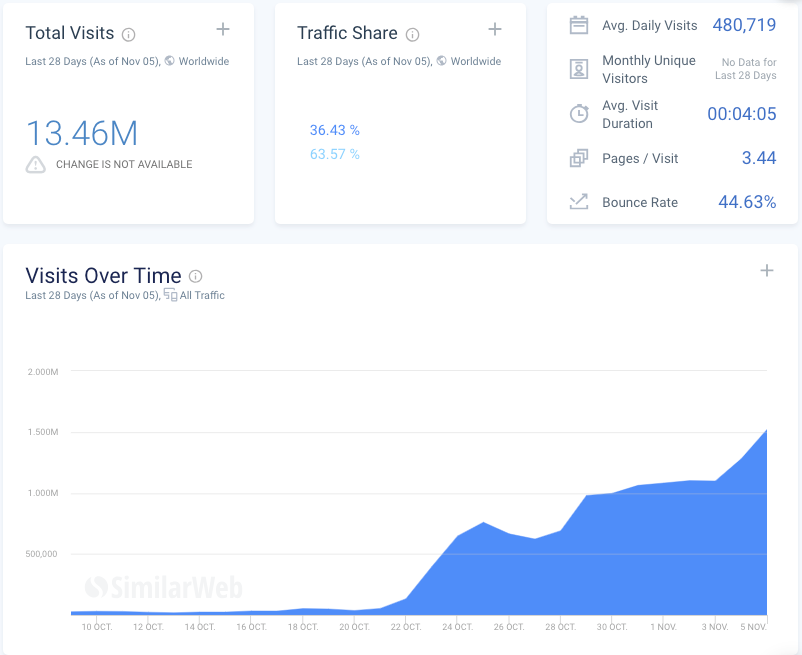
“Initiative Q is an attempt by ex-PayPal guys to create a new payment system—There’s nothing to lose but if this payment system becomes a world leading payment method your Qs can be worth a lot.” That’s the abridged opener spreading like wildfire across social media. 2 million people have already joined the fray (according to the company’s own figures); the majority of which have done so in the past two weeks—although it’s been around for 6 months. To get a better feel for what’s at the heart of Initiative Q, we took a closer look at its setup, make-up and higher-ups.
“Q is tomorrow’s payment network—To get millions to join, we are giving away our future currency.” That’s the welcome message unregistered users see when they first access the Initiative Q homepage, and it’s followed by a prominently placed running ticker of the current amount of “Qs” (the currency name) users receive upon signing up. But users may only sign up after receiving an invite to do so. Fortunately enough for interested persons, Initiative Q has standardized Facebook and Twitter posts just a click away to streamline the invite request process.
1.5 million in engagement figures on Facebook
The pre-fab form is hardly necessary anymore. IF you haven’t already been sent an invite by someone in your network, or seen one in any of your feeds, a simple Google search solves that for you: Hundreds of thousands of previously registered Initiative Q users are vying for new user sign-ups with open posts and comments, plus the corresponding link. And it’s not due to altruism or excitement for a new payment system. It’s purely in every user’s self-interests to generate as many new sign-ups as possible as every link used to sign up gives you more Qs.
The tactic has, to put it mildly, been a massive hit. A look at performance figures from any of the commonplace analytics tools shows that Initiative Q’s social spread in the past 2 plus weeks has been real and spectacular. According to Crowdtangle, a social analytics tool (that has since been acquired by Facebook), public posts containing the URL to the Initiative Q registration page (InitiativeQ.com/Invite), have generated 2.2 million interactions, including 1 million comments and more than 700K shares. The total reach would figure to be an order greater—and that’s without considering posts and messages from other platforms like Twitter, WhatsApp and Youtube, which were not included in Crowdtangle’s reporting.
2 million sign-ups, 13.4 million website impressions
Stat tool Similarweb paints a similar picture, estimating visits to Initiative Q’s landing page to be at 13.4 million in the past 28 days–the majority of which coming between October 23 and October 30.
The people behind Initative Q are also publicly stating impressive, if not incredible, numbers. Recently they wanted to celebrate hitting the 1-million-user milestone, but couldn’t because, according to this Facebook post from October 30th, “by the time we found a free second to put this text together over two million people from more than 180 countries have already signed up.”
Is Initiative Q already bigger than Ethereum?
The viral wave it’s been riding has long since washed it up on the shores of the mainstream. Major news outlets like the BBC and the Financial Times have reported (critically) on Initiative Q. The coverage increases its reach and further plants it in our collective consciousness and according to Google, “initiative q” is searched for more often than the (second-largest) cryptocurrency Ethereum.
Where does the sudden success come from?
Initiative Q’s overnight success is as incredible as it is stunning. Even as Initiative Q itself is distancing themselves directly from cryptocurrencies, the comparison has some merit as it’s promoting an “Initial Coin Offering.” But still, it is far-fetched to think a normal ICO could ever come close to garnering such awareness. On top of that: if you view the Google search performance as an indicator, why is it all of a sudden such a hit some six months after launching to little fanfare this past June?
One assumption is that social influencers and/or media outlets with substantial reach pushed the project, either paid or unpaid. However, OMR was unable to verify the assumption through a variety of analytics tools.
Rephrasing to the top?
Upon reading a blog post by British blockchain and cryptocurrency journalist David Gerard, where he took a critical look at Initiative Q, we noticed something: Initiative Q made some critical alterations to its opening soliloquy, which registered users could send to members of their network to invite them to join Initiative Q. After OMR contacted Initiative Q by email, a company spokesperson explained the change as a result of feedback they had received that “the old message had not conveyed the essence of the project in a meaningful enough manner.” The text was gradually modified beginning last October.
The original Initiative Q copy:
“Initiative Q is building a new payment network. To get people to adopt it, they’re giving away significant sums of their future currency to early people. They require only name, email, and an invite from an existing user. Here’s my invite link: https://initiativeq.com/invite/XXXXXXXXX Initiative Q will only succeed if many people join. The more people invite their friends, the greater the likelihood of reaching the goal of each Q being worth around one US dollar.”
The new copy is decidedly different:
The current invite copy from Initiative Q:
“Initiative Q is an attempt by ex-PayPal guys to create a new payment system instead of credit cards that were designed in the 1950s. The system uses its own currency, the Q, and to get people to start using the system once it’s ready they are allocating Qs for free to people that sign up now (the amount drops as more people join – so better to join early). Signing up is free and they only ask for your name and an email address. There’s nothing to lose but if this payment system becomes a world leading payment method your Qs can be worth a lot. If you missed getting bitcoin seven years ago, you wouldn’t want to miss this. Here is my invite link: https://initiativeq.com/invite/XXXXXXXXX This link will stop working once I’m out of invites. Let me know after you registered, because I need to verify you on my end.” (Emphasis: OMR)
Can it really be that simple? That Initiative Q’s insane growth can be attributed to a simple text edit? Seems unlikely until you consider that that copy is the first point of contact for many people. What is beyond speculation is the chronological correlation between the text edit and the project really taking off.
Let’s parse the text
1. Name-dropping Paypal to boost confidence
In the opening stanza, Initiative Q is able to score trust points twice among recipients; the first being the recommendation from a friend or acquaintance in the user’s network. Second, by mentioning Paypal trust is further boosted because the company is run by the people behind the only digital payment system that was able to penetrate the mainstream and enjoy wide-scale consumer trust.
Then there is the fact that many people, who are only a peripheral participants in digital business, may have heard the term “Paypal Mafia.” The original brains behind Paypal are to this day incredibly influential figures in the US tech scene and beyond. Six of them are billionaires, including Elon Musk, high-profile investor Peter Thiel and Linkedin founder Reid Hoffman. By name-dropping Paypal to readers privy to this information, Initiative Q is able to tacitly communicate: when this star-studded cast takes something on, it’s potential is massive. Ironically enough, Saar Wilf, founder of Initiative Q, was not among the founders of Paypal; Wilf founded Fraud Sciences Corp., which was acquired by Paypal in 2008 and integrated into its own software.
2. FOMO FO REAL
In contrast to the previous text version, the new invite text creates “Fear of Missing Out” amongst recipients “(the amount drops as more people join – so better to join early).” Signing up is free and they only ask for your name and an email address. There’s nothing to lose but if this payment system becomes a world leading payment method your Qs can be worth a lot. This link will stop working once I’m out of invites.” Initially, the phrase “the value of the reward would be around USD 130,000” was contained in the initial text, as this Twitter post points out. German tech blogger Felix Beilharz aptly dubbed the mechanic “Reverse risk” (Risikoumkehr): it’s riskier not to participate then just signing up quickly.
The last part ensuring that greed wins out over reason is the reference to Bitcoin: “If you missed getting bitcoin seven years ago, you wouldn’t want to miss this.” With it, Initiative Q was able to exploit the perfect pressure point to convince users to register. Thanks to the incredible heights at which the cryptocurrency was trading last year, the topic forced itself into the mainstream, therefore becoming a trigger for many.
3. The emphasis on “free”
Even before Initiative Q modified the sign-up text, registering was free. Needing the email address and user is characterized as all they need—something that subconsciously registers as a negative. Additionally, where they previously spoke of a “future currency,” the new text makes a point of saying “free Qs.”
It’s possible that these changes are, from a marketing perspective, responsible for allowing the campaign to reach its full potential. The fundamental principal in referral marketing of rewarding both sides for registering is also a fundamental pillar of growth hacking. Just look at Dropbox for an especially successful referral campaign, which generated new user sign ups by giving referrer and referee additional memory.
Growth Hacking 101 20
Paypal, too, implemented a similar method and gave early users free money via a referral program: at first, every user received USD 20 for signing up and an additional USD 20 for each new sign up they initiated. The ploy worked out for PayPal, netting them 100 million new users. The thought behind the cost-intensive user-generation method: new platforms and marketplaces have to spend money to make money—so why not just give the money spend straight to users, make them product ambassadors and create snowball effects?
Initiative Q didn’t even have to incur any financial obligations ahead of time, as the currency does not possess any kind of value. From a cost perspective that means everything. On the other hand, it lessens the attractiveness of signing up for users and increases trepidation among users to sign up.
Pressure or “Incentive”?
The campaign mechanic and rephrasing, however, has enabled the makers to create enough pressure (or incentive for a more positive term) on already registered users and potential new sign-ups. New users are encouraged to invite five new users within 96 hours to secure more Qs. By limiting the free slots to the first five, potentially interested parties are prompted to accept the invite as quickly as possible.
Once you’ve sent out all of your invites, you can send out 10 more and thus boost your Qs further. Then if users, who are invited by another member, invite additional users, the original user receives even more Qs. Social media expert Felix Beilharz played the game to the end and found that 40 invites is the limit. Appearances indicate that additional Qs can only be acquired by users indirectly, via third degree invites, according to Beilharz. The Initiative Q FAQs state that future users can receive additional Qs by fulfilling additional tasks like downloading the app or making a purchase wth Qs.
Pyramid scheme or not?
With the tiered award structure, Initiative Q ticks off a fundamental box when it comes to what a pyramid scheme is. Initiative Q seems to be aware of how the project could be interpreted, as this tweet illustrates:
Wilf told “Tech in Asia” that he views Visa as his primary competitor. Beginning in 2021, Initiative Q is aiming to be the world’s largest payment network, as a detailed roadmap points out on the website. Several media outlets are reporting that economics professor Lawrence H. White from George Mason University is behind the “economic and monetary models” behind Initiative Q. His name does not appear on the company website.
If you’re not paying for it…
Crypto-journalist David Gerard is very critical of Initiative Q saying that he while he doesn’t believe that “the operators are scam artists,” he does not have a clear idea of how the Initiative Q payment system could look and doesn’t even see a rough plan for it at the moment. “So they’re recruiting people with Q tokens as future lottery tickets, so they can get merchants—and, presumably, venture capitalists—on board by saying, “we have this huge number of users. But first, they need to get past the problem that none of this exists yet—everything in their pitch is completely imaginary—and they literally don’t have a plan yet.” (Initiative-Q founder Saar Wilf did respond to David Gerard’s critique in detail.)


























